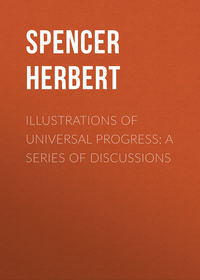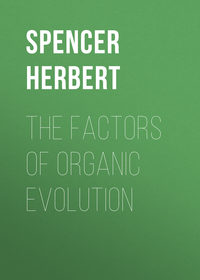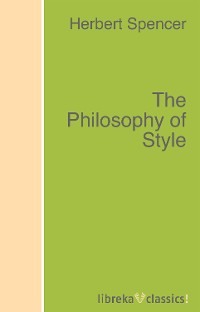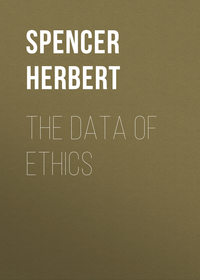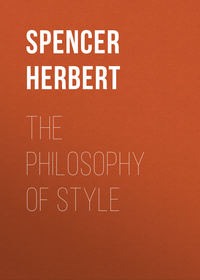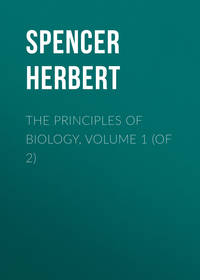 полная версия
полная версияFirst Principles
Before passing to other classes of facts, it should be observed that the evolution of the homogeneous into the heterogeneous is displayed not only in the separation of Painting and Sculpture from Architecture and from each other, and in the greater variety of subjects they embody; but it is further shown in the structure of each work. A modern picture or statue is of far more heterogeneous nature than an ancient one. An Egyptian sculpture-fresco represents all its figures as on one plane – that is, at the same distance from the eye; and so is less heterogeneous than a painting that represents them as at various distances from the eye. It exhibits all objects as exposed to the same degree of light; and so is less heterogeneous than a painting which exhibits different objects, and different parts of each object, as in different degrees of light. It uses scarcely any but the primary colours, and these in their full intensity; and so is less heterogeneous than a painting which, introducing the primary colours but sparingly, employs an endless variety of intermediate tints, each of heterogeneous composition, and differing from the rest not only in quality but in intensity. Moreover, we see in these earliest works a great uniformity of conception. The same arrangement of figures is perpetually reproduced – the same actions, attitudes, faces, dresses. In Egypt the modes of representation were so fixed that it was sacrilege to introduce a novelty; and indeed it could have been only in consequence of a fixed mode of representation that a system of hieroglyphics became possible. The Assyrian bas-reliefs display parallel characters. Deities, kings, attendants, winged-figures and animals, are severally depicted in like positions, holding like implements, doing like things, and with like expression or non-expression of face. If a palm-grove is introduced, all the trees are of the same height, have the same number of leaves, and are equidistant. When water is imitated, each wave is a counterpart of the rest; and the fish, almost always of one kind, are evenly distributed over the surface. The beards of the kings, the gods, and the winged-figures, are everywhere similar; as are the manes of the lions, and equally so those of the horses. Hair is represented throughout by one form of curl. The king’s beard is quite architecturally built up of compound tiers of uniform curls, alternating with twisted tiers placed in a transverse direction, and arranged with perfect regularity; and the terminal tufts of the bulls’ tails are represented in exactly the same manner. Without tracing out analogous facts in early Christian art, in which, though less striking, they are still visible, the advance in heterogeneity will be sufficiently manifest on remembering that in the pictures of our own day the composition is endlessly varied; the attitudes, faces, expressions, unlike; the subordinate objects different in size, form, position, texture; and more or less of contrast even in the smallest details. Or, if we compare an Egyptian statue, seated bolt upright on a block, with hands on knees, fingers outspread and parallel, eyes looking straight forward, and the two sides perfectly symmetrical in every particular, with a statue of the advanced Greek or the modern school, which is asymmetrical in respect of the position of the head, the body, the limbs, the arrangement of the hair, dress, appendages, and in its relations to neighbouring objects, we shall see the change from the homogeneous to the heterogeneous clearly manifested.
§ 51. In the co-ordinate origin and gradual differentiation of Poetry, Music, and Dancing, we have another series of illustrations. Rhythm in speech, rhythm in sound, and rhythm in motion, were in the beginning, parts of the same thing; and have only in process of time become separate things. Among various existing barbarous tribes we find them still united. The dances of savages are accompanied by some kind of monotonous chant, the clapping of hands, the striking of rude instruments: there are measured movements, measured words, and measured tones; and the whole ceremony, usually having reference to war or sacrifice, is of governmental character. In the early records of the historic races we similarly find these three forms of metrical action united in religious festivals. In the Hebrew writings we read that the triumphal ode composed by Moses on the defeat of the Egyptians, was sung to an accompaniment of dancing and timbrels. The Israelites danced and sung “at the inauguration of the golden calf. And as it is generally agreed that this representation of the Deity was borrowed from the mysteries of Apis, it is probable that the dancing was copied from that of the Egyptians on those occasions.” There was an annual dance in Shiloh on the sacred festival; and David danced before the ark. Again, in Greece the like relation is everywhere seen: the original type being there, as probably in other cases, a simultaneous chanting and mimetic representation of the life and adventures of the god. The Spartan dances were accompanied by hymns and songs; and in general the Greeks had “no festivals or religious assemblies but what were accompanied with songs and dances” – both of them being forms of worship used before altars. Among the Romans, too, there were sacred dances: the Salian and Lupercalian being named as of that kind. And even in Christian countries, as at Limoges in comparatively recent times, the people have danced in the choir in honour of a saint. The incipient separation of these once united arts from each other and from religion, was early visible in Greece. Probably diverging from dances partly religious, partly warlike, as the Corybantian, came the war-dances proper, of which there were various kinds; and from these resulted secular dances. Meanwhile Music and Poetry, though still united, came to have an existence separate from dancing. The aboriginal Greek poems, religious in subject, were not recited but chanted; and though at first the chant of the poet was accompanied by the dance of the chorus, it ultimately grew into independence. Later still, when the poem had been differentiated into epic and lyric – when it became the custom to sing the lyric and recite the epic – poetry proper was born. As during the same period musical instruments were being multiplied, we may presume that music came to have an existence apart from words. And both of them were beginning to assume other forms besides the religious. Facts having like implications might be cited from the histories of later times and peoples; as the practices of our own early minstrels, who sang to the harp heroic narratives versified by themselves to music of their own composition: thus uniting the now separate offices of poet, composer, vocalist, and instrumentalist. But, without further illustration, the common origin and gradual differentiation of Dancing, Poetry, and Music will be sufficiently manifest.
The advance from the homogeneous to the heterogeneous is displayed not only in the separation of these arts from each other and from religion, but also in the multiplied differentiations which each of them afterwards undergoes. Not to dwell upon the numberless kinds of dancing that have, in course of time, come into use; and not to occupy space in detailing the progress of poetry, as seen in the development of the various forms of metre, of rhyme, and of general organization; let us confine our attention to music as a type of the group. As argued by Dr. Burney, and as implied by the customs of still extant barbarous races, the first musical instruments were, without doubt, percussive – sticks, calabashes, tom-toms – and were used simply to mark the time of the dance; and in this constant repetition of the same sound, we see music in its most homogeneous form. The Egyptians had a lyre with three strings. The early lyre of the Greeks had four, constituting their tetrachord. In course of some centuries lyres of seven and eight strings were employed. And, by the expiration of a thousand years, they had advanced to their “great system” of the double octave. Through all which changes there of course arose a greater heterogeneity of melody. Simultaneously there came into use the different modes – Dorian, Ionian, Phrygian, Æolian, and Lydian – answering to our keys: and of these there were ultimately fifteen. As yet, however, there was but little heterogeneity in the time of their music. Instrumental music during this period being merely the accompaniment of vocal music, and vocal music being completely subordinated to words, – the singer being also the poet, chanting his own compositions and making the lengths of his notes agree with the feet of his verses; there unavoidably arose a tiresome uniformity of measure, which, as Dr Burney says, “no resources of melody could disguise.” Lacking the complex rhythm obtained by our equal bars and unequal notes, the only rhythm was that produced by the quantity of the syllables, and was of necessity comparatively monotonous. And further, it may be observed that the chant thus resulting, being like recitative, was much less clearly differentiated from ordinary speech than is our modern song. Nevertheless, considering the extended range of notes in use, the variety of modes, the occasional variations of time consequent on changes of metre, and the multiplication of instruments, we see that music had, towards the close of Greek civilization, attained to considerable heterogeneity: not indeed as compared with our music, but as compared with that which preceded it. As yet, however, there existed nothing but melody: harmony was unknown. It was not until Christian church-music had reached some development, that music in parts was evolved; and then it came into existence through a very unobtrusive differentiation. Difficult as it may be to conceive, à priori, how the advance from melody to harmony could take place without a sudden leap, it is none the less true that it did so. The circumstance which prepared the way for it, was the employment of two choirs singing alternately the same air. Afterwards it became the practice (very possibly first suggested by a mistake) for the second choir to commence before the first had ceased; thus producing a fugue. With the simple airs then in use, a partially harmonious fugue might not improbably thus result; and a very partially harmonious fugue satisfied the ears of that age, as we know from still preserved examples. The idea having once been given, the composing of airs productive of fugal harmony would naturally grow up; as in some way it did grow up out of this alternate choir-singing. And from the fugue to concerted music of two, three, four, and more parts, the transition was easy. Without pointing out in detail the increasing complexity that resulted from introducing notes of various lengths, from the multiplication of keys, from the use of accidentals, from varieties of time, from modulations and so forth, it needs but to contrast music as it is, with music as it was, to see how immense is the increase of heterogeneity. We see this if, looking at music in its ensemble, we enumerate its many different genera and species – if we consider the divisions into vocal, instrumental, and mixed; and their subdivisions into music for different voices and different instruments – if we observe the many forms of sacred music, from the simple hymn, the chant, the canon, motet, anthem, &c., up to the oratorio; and the still more numerous forms of secular music, from the ballad up to the serenata, from the instrumental solo up to the symphony. Again, the same truth is seen on comparing any one sample of aboriginal music with a sample of modern music – even an ordinary song for the piano; which we find to be relatively highly heterogeneous, not only in respect of the varieties in the pitch and in the length of the notes, the number of different notes sounding at the same instant in company with the voice, and the variations of strength with which they are sounded and sung, but in respect of the changes of key, the changes of time, the changes of timbre of the voice, and the many other modifications of expression. While between the old monotonous dance-chant and a grand opera of our own day, with its endless orchestral complexities and vocal combinations, the contrast in heterogeneity is so extreme that it seems scarcely credible that the one should have been the ancestor of the other.
§ 52. Were they needed, many further illustrations might be cited. Going back to the early time when the deeds of the god-king, chanted and mimetically represented in dances round his altar, were further narrated in picture-writings on the walls of temples and palaces, and so constituted a rude literature, we might trace the development of Literature through phases in which, as in the Hebrew Scriptures it presents in one work, theology, cosmogony, history, biography, civil law, ethics, poetry; through other phases in which, as in the Iliad, the religious, martial, historical, the epic, dramatic, and lyric elements are similarly commingled; down to its present heterogeneous development, in which its divisions and subdivisions are so numerous and varied as to defy complete classification. Or we might track the evolution of Science: beginning with the era in which it was not yet differentiated from Art, and was, in union with Art, the handmaid of Religion; passing through the era in which the sciences were so few and rudimentary, as to be simultaneously cultivated by the same philosophers; and ending with the era in which the genera and species are so numerous that few can enumerate them, and no one can adequately grasp even one genus. Or we might do the like with Architecture, with the Drama, with Dress. But doubtless the reader is already weary of illustrations; and my promise has been amply fulfilled. I believe it has been shown beyond question, that that which the German physiologists have found to be the law of organic development, is the law of all development. The advance from the simple to the complex, through a process of successive differentiations, is seen alike in the earliest changes of the Universe to which we can reason our way back, and in the earliest changes which we can inductively establish; it is seen in the geologic and climatic evolution of the Earth, and of every single organism on its surface; it is seen in the evolution of Humanity, whether contemplated in the civilized individual, or in the aggregation of races; it is seen in the evolution of Society, in respect alike of its political, its religious, and its economical organization; and it is seen in the evolution of all those endless concrete and abstract products of human activity, which constitute the environment of our daily life. From the remotest past which Science can fathom, up to the novelties of yesterday, that in which Evolution essentially consists, is the transformation of the homogeneous into the heterogeneous.
CHAPTER III.
THE LAW OF EVOLUTION, CONTINUED
§ 53. But now, does this generalization express the whole truth? Does it include all the phenomena of Evolution? and does it exclude all other phenomena? A careful consideration of the facts, will show that it does neither.
That there are changes from the less heterogeneous to the more heterogeneous, which do not come within what we call Evolution, is proved in every case of local disease. A portion of the body in which there arises a cancer, or other morbid growth, unquestionably displays a new differentiation. Whether this morbid growth be, or be not, more heterogeneous than the tissues in which it is seated, is not the question. The question is, whether the structure of the organism as a whole, is, or is not, rendered more heterogeneous by the addition of a part unlike every pre-existing part, both in form and composition. And to this question there can be none but an affirmative answer. Again, it might with apparent truth be contended, that the earlier stages of decomposition in a dead body, similarly involve an increase of heterogeneity. Supposing the chemical changes to commence in some parts of the body earlier than in other parts, as they commonly do; and to affect different tissues in different, ways, as they must; it seems to be a necessary admission that the entire body, made up of undecomposed parts and parts decomposed in different ways and degrees, has become more heterogeneous than it was. Though greater homogeneity will be the eventual result, the immediate result is the opposite. And yet this immediate result is certainly not evolution. But perhaps of all illustrations the least debatable are those furnished by social disorders and disasters. When in any nation there occurs a rebellion, which, while leaving some provinces undisturbed, developes itself here in secret societies, there in public demonstrations, and elsewhere in actual appeal to arms, leading probably to conflict and bloodshed; it must be admitted that the society, regarded as a whole, has so been rendered more heterogeneous. Or when a dearth causes commercial panic with its entailed bankruptcies, closed factories, discharged operatives, political agitations, food riots, incendiarisms; it is manifest that as, throughout the rest of society, there still exists the ordinary organization displaying the usual phenomena, these new phenomena must be regarded as adding to the complexity previously existing. Nevertheless, it is clear that such changes so far from constituting a further stage of evolution, are steps towards dissolution.
There is good reason to think then, that the definition arrived at in the last chapter, is an imperfect one. We may suspect, not that the process of evolution is different from the process there described; but that the description did not contain all that it should. The changes above instanced as coming within the formula as it now stands, are so obviously different from the rest, that the inclusion of them implies some oversight – some distinction hitherto overlooked. Such further distinction we shall find really exists.
§ 54. At the same time that all evolution is a change from the homogeneous to the heterogeneous, it is also a change from the indefinite to the definite. As well as an advance from simplicity to complexity, there is an advance from confusion to order – from undetermined arrangement to determined arrangement. In the process of development, no matter what sphere it is displayed in, there is not only a gradual multiplication of unlike parts; but there is a gradual increase in the distinctness with which these parts are marked off from each other. And so is that increase of heterogeneity which characterizes Evolution, distinguished from that increase of heterogeneity which does not. For proof of this, it needs only to reconsider the instances given above. The structural changes constituting a disease, have no such definiteness, either in locality, extent, or outline, as the structural changes constituting development. Though certain morbid growths arise much more commonly in some parts of the body than in others (as warts on the hands, cancer on the breasts, tubercle in the lungs), yet they are not confined to these parts; nor, when found on them, are they anything like so precise in their relative positions as are the normal parts around them. In size, again, they are extremely variable – they bear no such constant proportion to the body as organs do. Their forms, too, are far less specific than organic forms. And they are extremely irregular or confused in their internal structures. That is to say, they are in all respects comparatively indefinite. The like peculiarity may be traced in decomposition. That state of total indefiniteness to which a dead body is finally reduced, is a state towards which the putrefactive changes have tended from their commencement. Each step in the destruction of the organic compounds, is accompanied by a blurring of the minute structure – diminishes its distinctness. From the portions that have undergone most decomposition, there is a gradual transition to the less decomposed portions. And step by step the lines of organization, once so precise, disappear. Similarly with social changes of an abnormal kind. A political outbreak rising finally to a rebellion, tends from the very first to obliterate the specializations, governmental and industrial, which previously existed. The disaffection which originates such an outbreak, itself implies a loosening of those ties by which the citizens are bound up into distinct classes and sub-classes. Agitation, growing into revolutionary meetings, shows us a decided tendency towards the fusion of ranks that are usually separated. Acts of open insubordination exhibit a breaking through of those definite limits to individual conduct which were previously observed; and a disappearance of the lines previously existing between those in authority and those beneath them. At the same time, by the arrest of trade, artizans and others lose their occupations; and in so ceasing to be functionally distinguished, become fused into a mass from which the demarcations in great part vanish. And when at last there comes positive insurrection, all magisterial and official powers, all class distinctions, and all industrial differences, at once cease: organized society lapses into an unorganized aggregation of social units. How the like holds true of such social disasters as are entailed by famine, needs not be pointed out. On calling to mind that in cases of this kind the changes are from order towards disorder, it will at once be seen that like the foregoing they are changes from definite arrangements to indefinite arrangements.
Thus then is that increase of heterogeneity which constitutes Evolution, distinguished from that increase of heterogeneity which does not do so. Though in disease and death, individual or social, the earliest modifications may be construed as additions to the heterogeneity previously existing; yet they cannot be construed as additions to the definiteness previously existing. They begin from the very outset to destroy this definiteness; and so, gradually produce a heterogeneity that is indeterminate instead of determinate. Just in the same way that a city, already multiform in its variously arranged structures of various architecture, may be made more multiform by an earthquake, which leaves part of it standing and overthrows other parts in different ways and degrees, and yet is at the same time reduced from definite arrangement to indefinite arrangement; so may organized bodies be made for a time more multiform by changes which are nevertheless disorganizing changes. And in the one case as in the other, it is the absence of definiteness which distinguishes the multiformity of regression from the multiformity of progression.
If the advance from the indefinite to the definite is an essential characteristic of Evolution, we shall of course find it everywhere displayed; as in the last Chapter we found the advance from the homogeneous to the heterogeneous. With a view of showing that it is so, let us now briefly reconsider the same several classes of facts.
§ 55. Beginning as before with a hypothetical illustration, we have to note that each further stage in the evolution of the Solar System, supposing it to have originated from diffused matter, was an advance towards more definite forms, and times, and forces. At first irregular in shape and with indistinct margins, the attenuated substance, as it concentrated and acquired a rotatory motion, must have assumed the shape of an oblate spheroid; which, with every increase of density, became more specific in general outline, and had its surface more sharply marked off from the surrounding void. At the same time, the constituent portions of nebulous matter, instead of independently moving towards their common centre of gravity from all points, and tending to revolve round it in various planes, as they would at first do, must have had these planes more and more merged into a single plane; and this plane must have gained greater precision as the concentration progressed. To which add that in the gradual establishment of a common and determinate angular velocity, instead of the various and conflicting angular velocities of different parts, we have a further change of like nature. According to the hypothesis, change from indistinct characteristics to distinct ones, was repeated in the evolution of each planet and satellite; and may in them be traced to a much greater extent. A gaseous spheroid is less definitely marked off from the space around it than a fluid spheroid, since it is subject to larger and more rapid undulations of surface, and to much greater distortions of general form; and similarly a fluid spheroid, covered as it must be with waves of various magnitudes, is less definite than a solid spheroid. Nor is it only in greater fixity of surface that a planet in its last stage, is distinguished from a planet in its earlier stages. Its general form, too, is more precise. The sphere, to which in the end it very closely approximates, is a perfectly specific figure; while the spheroid, under which figure it previously existed, being infinitely variable in oblateness, is an imperfectly specific figure. And further, a planet having an axis inclined to the plane of its orbit, must, while its form is very oblate, have its plane of rotation greatly disturbed by the attraction of external bodies; whereas its approach to a spherical form, involving a less extreme precessional motion, implies less marked variations in the direction of its axis. Nor is it only in respect of space-relations that the Solar System in general and in detail has become more precise. The like is true of time-relations. During the process of concentration the various portions of the nebulous mass must not only differ more or less from each other in their angular velocities, but each of them must gradually change the period in which it moves round the general axis. In every detached ring however, and in the resulting planet, this progressive alteration ceases: there results a determinate period of revolution. And similarly the time of axial rotation, which, during the formation of each planet, is continually diminishing, becomes at last practically fixed: as in the case of the Earth, whose day is not a second less than it was 2000 years ago. It is scarcely needful to point out that the force-relations have simultaneously become more and more settled. The exact calculations of physical astronomy, show us how definite these force-relations now are; while the great indefiniteness which once characterized them, is implied in the extreme difficulty, if not impossibility, of subjecting the nebular hypothesis to mathematical treatment.



